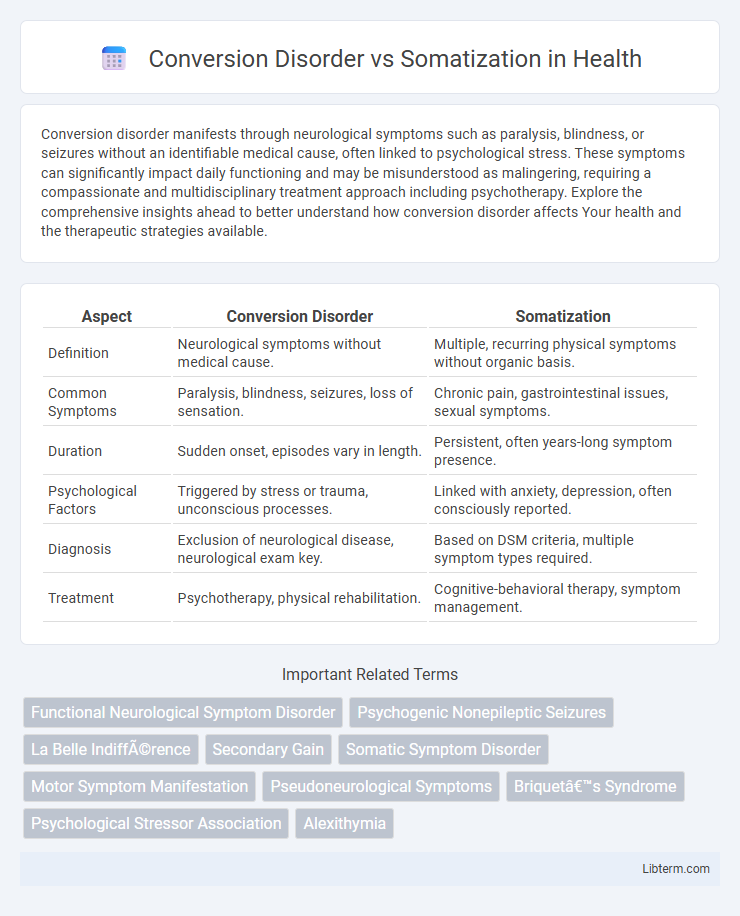Conversion disorder manifests through neurological symptoms such as paralysis, blindness, or seizures without an identifiable medical cause, often linked to psychological stress. These symptoms can significantly impact daily functioning and may be misunderstood as malingering, requiring a compassionate and multidisciplinary treatment approach including psychotherapy. Explore the comprehensive insights ahead to better understand how conversion disorder affects Your health and the therapeutic strategies available.
Table of Comparison
| Aspect | Conversion Disorder | Somatization |
|---|---|---|
| Definition | Neurological symptoms without medical cause. | Multiple, recurring physical symptoms without organic basis. |
| Common Symptoms | Paralysis, blindness, seizures, loss of sensation. | Chronic pain, gastrointestinal issues, sexual symptoms. |
| Duration | Sudden onset, episodes vary in length. | Persistent, often years-long symptom presence. |
| Psychological Factors | Triggered by stress or trauma, unconscious processes. | Linked with anxiety, depression, often consciously reported. |
| Diagnosis | Exclusion of neurological disease, neurological exam key. | Based on DSM criteria, multiple symptom types required. |
| Treatment | Psychotherapy, physical rehabilitation. | Cognitive-behavioral therapy, symptom management. |
Introduction to Conversion Disorder and Somatization
Conversion disorder involves neurological symptoms such as paralysis, blindness, or seizures without a medical cause, linked to psychological stress, whereas somatization disorder is characterized by multiple, recurrent physical complaints across various organ systems, unexplained by medical conditions. Both are classified under somatic symptom and related disorders in the DSM-5, highlighting the mind-body connection in symptom manifestation. Conversion disorder often presents with specific neurological deficits, while somatization disorder involves broader, chronic physical symptoms affecting daily functioning.
Defining Conversion Disorder: Key Features
Conversion disorder, also known as functional neurological symptom disorder, manifests through neurological symptoms such as paralysis, blindness, or seizures without identifiable organic causes. Key features include symptom presentation that is incompatible with recognized neurological or medical conditions and often linked to psychological stress or trauma. Unlike somatization disorder, which involves multiple, chronic physical complaints across various organ systems, conversion disorder symptoms are typically acute and localized.
Understanding Somatization: Essential Characteristics
Somatization involves multiple, recurrent physical symptoms across various bodily systems without a clear medical cause, often linked to psychological distress. Patients typically report pain, gastrointestinal problems, and neurological complaints, reflecting a complex mind-body interaction that challenges diagnosis. Understanding somatization requires recognizing its chronic nature and the significant impact on quality of life, differentiating it from Conversion Disorder, which primarily manifests as neurological symptoms like paralysis or blindness with no organic basis.
Differences in Symptom Presentation
Conversion disorder primarily involves neurological symptoms such as paralysis, blindness, or seizures without a medical cause, often mimicking specific neurological conditions. Somatization disorder presents with multiple, chronic physical complaints across various bodily systems, including pain, gastrointestinal, and sexual symptoms, without identifiable organic pathology. The key difference lies in conversion disorder's distinct, dramatic neurological deficits compared to somatization's broad range of persistent, non-neurological complaints.
Diagnostic Criteria: DSM-5 Comparison
Conversion Disorder, also known as Functional Neurological Symptom Disorder, requires one or more symptoms of altered voluntary motor or sensory function that are inconsistent with recognized neurological or medical conditions according to DSM-5 criteria. Somatic Symptom Disorder involves persistent somatic symptoms causing significant distress and impairment, accompanied by excessive thoughts, feelings, or behaviors related to the symptoms, as outlined by DSM-5. The key diagnostic distinction lies in Conversion Disorder's neurological symptom presentation without medical explanation, whereas Somatic Symptom Disorder focuses on disproportionate psychological responses to somatic symptoms.
Underlying Psychological Mechanisms
Conversion disorder primarily involves unconscious psychological conflicts manifesting as neurological symptoms such as paralysis or seizures, reflecting a disruption in normal sensorimotor processing pathways. Somatization disorder is characterized by multiple, recurrent physical complaints that lack a clear medical cause, linked to chronic stress and heightened bodily awareness mediated by altered central nervous system sensitization. Both disorders highlight the complex interplay between emotional distress and neurobiological mechanisms, with conversion disorder emphasizing dissociative responses and somatization involving persistent symptom amplification.
Common Triggers and Risk Factors
Conversion disorder often arises after acute stressors such as traumatic events or emotional conflict, with risk factors including a history of neurological disorders and psychological trauma. Somatization commonly develops from chronic stress, childhood abuse, and a family history of psychiatric disorders, frequently triggered by ongoing interpersonal difficulties or medical illnesses. Both conditions show higher prevalence among females and individuals with lower socioeconomic status, emphasizing the role of psychosocial stress in symptom manifestation.
Treatment Approaches: Conversion Disorder vs Somatization
Treatment approaches for Conversion Disorder primarily involve cognitive-behavioral therapy (CBT) to address the underlying psychological conflict manifesting as neurological symptoms, alongside physical rehabilitation to restore motor function. In contrast, Somatization treatment emphasizes psychotherapy aimed at improving coping strategies and reducing health anxiety, often combined with pharmacotherapy to manage associated mood or anxiety disorders. Both disorders benefit from a multidisciplinary approach incorporating psychological support, but Conversion Disorder requires a more targeted focus on symptom retraining and functional recovery.
Prognosis and Long-term Outcomes
Conversion Disorder prognosis often involves sudden symptom resolution, but some patients experience chronic or recurrent episodes with varying long-term outcomes influenced by early intervention and psychosocial support. Somatization typically presents a more persistent course with fluctuating physical complaints, posing challenges for long-term management and often leading to significant impairment in daily functioning. Long-term outcomes in both disorders improve with integrated psychiatric care, cognitive-behavioral therapy, and multidisciplinary approaches targeting symptom management and psychological stressors.
Importance of Accurate Diagnosis and Misconceptions
Accurate diagnosis of Conversion Disorder and Somatization is crucial to ensure appropriate treatment, as these conditions share overlapping symptoms but differ fundamentally in etiology; Conversion Disorder involves neurological symptoms without organic cause, whereas Somatization includes multiple physical complaints linked to psychological distress. Misconceptions often lead to misdiagnosis, resulting in ineffective interventions and prolonged patient suffering. Differentiating these disorders through thorough clinical evaluation and understanding of psychiatric criteria enhances patient outcomes and reduces healthcare costs.
Conversion Disorder Infographic

 libterm.com
libterm.com